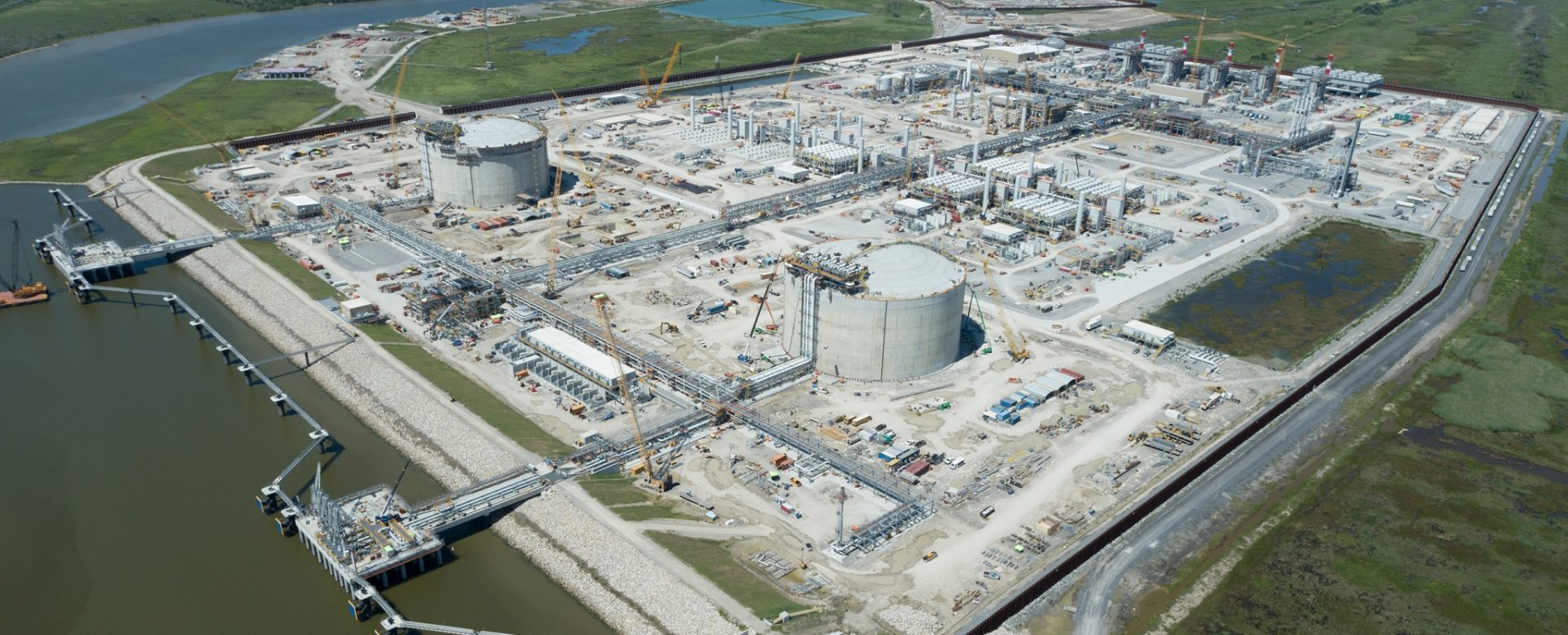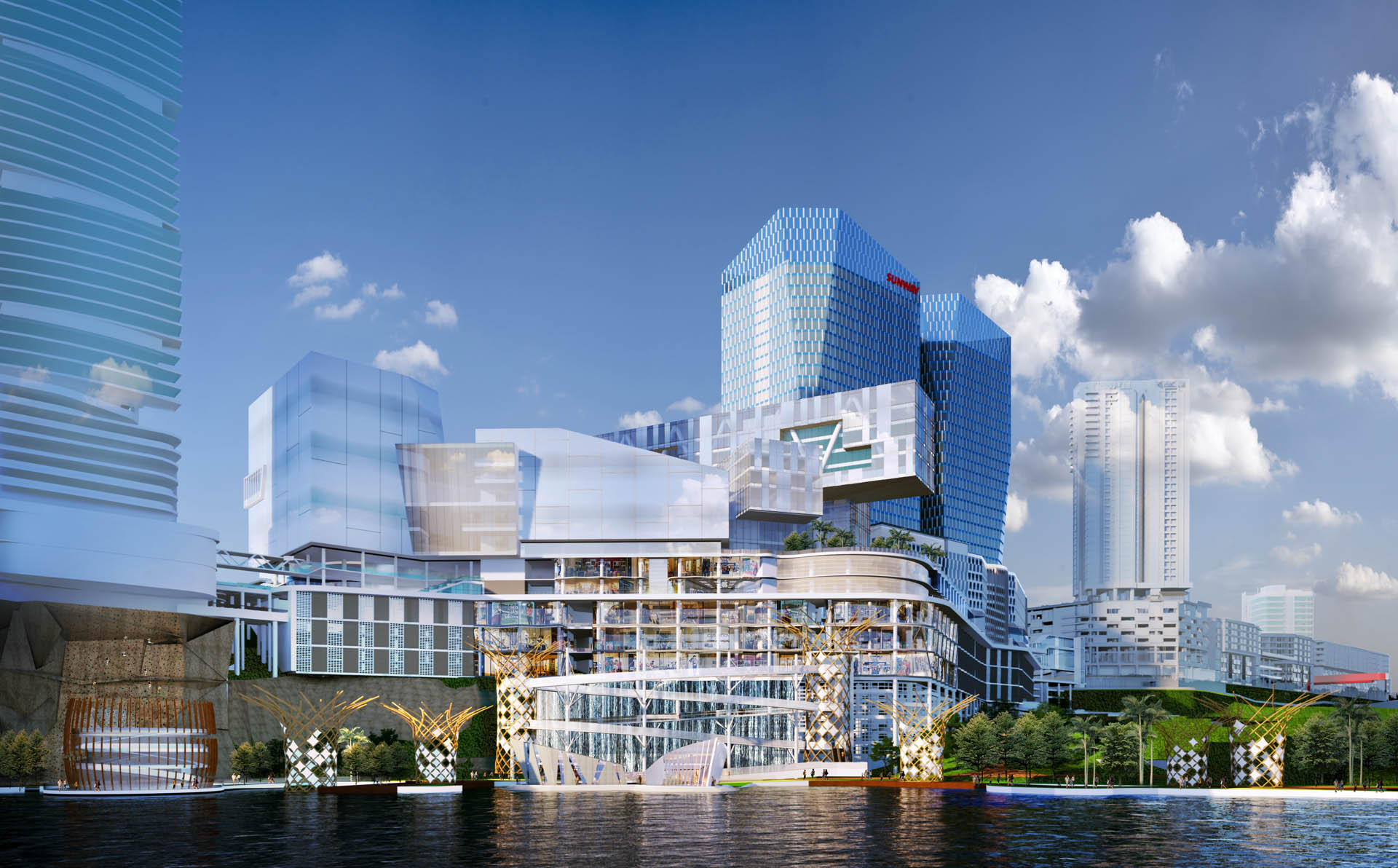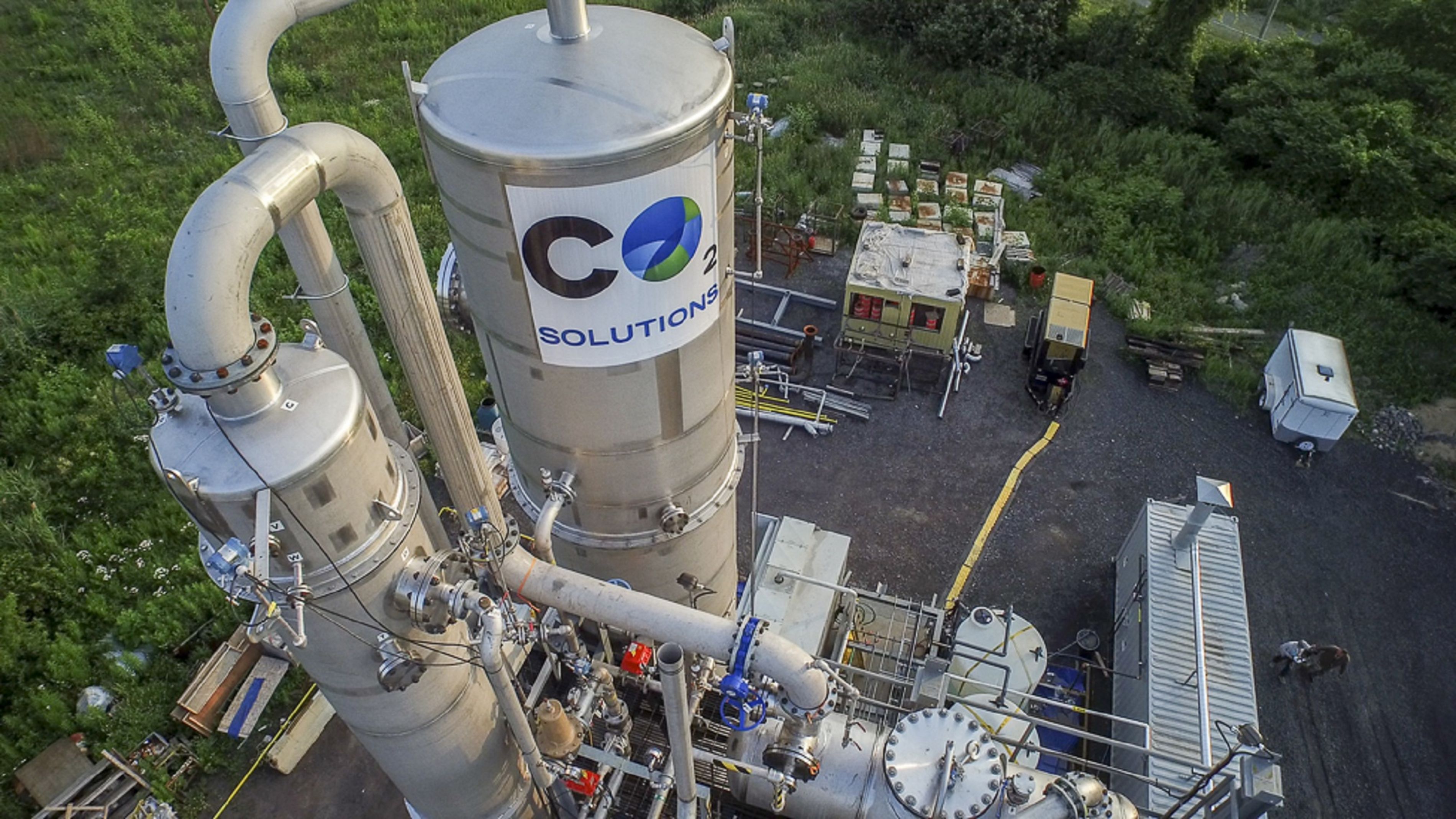
The original Calcasieu Pass gas plant in Hackberry, Louisiana.
Despite Pressure to Halt Louisiana Project,
Biden Touts Gas Exports to Europe
Oliver Milman / Guardian UK
(October 24, 2023) — Joe Biden’s administration is under mounting pressure to block construction of what would be one of the world’s largest gas export hubs, and which would be perched near the rapidly eroding Louisiana shoreline, due to concerns over its impact on the climate and communities living amid an unprecedented expansion of new gas infrastructure along the Gulf of Mexico.
The $10 billion project, known as Calcasieu Pass 2 (or CP2), is being planned for Cameron parish, on Louisiana’s coast. It would involve bringing gas extracted via fracking through a new pipeline to a terminal where it would be condensed into liquid, chilled to -260F (-162C) and sent on ships for export to other markets, including in Europe.
CP2, which would ship up to 24m tons of liquified natural gas (LNG) each year once built, is at the vanguard of a huge surge in new gas pipelines and terminals that are increasingly dotting the Gulf coast. The Biden administration, which has so far mostly allowed this enormous build-out, has talked up gas exports to European allies in the wake of Russia’s invasion of Ukraine.
Environmental groups have warned that Biden risks blowing apart his own efforts to combat the climate crisisin the US and endanger international climate goals by allowing terminals such as CP2, which is likely to be decided upon by federal regulators within the next month.
“That we would even consider doing anything like this in 2023, which scientists have told us is the hottest year we have experienced on this planet for 125,000 years, is obscene and dangerous,” said Bill McKibben, the climate activist and co-founder of 350.org, who said the magnitude of the new gas facilities is still largely unknown to most Americans.
“The world has never been hotter – why on Earth are we even talking about finding a way to spew even more greenhouse gases into the atmosphere?”
The growth of the gas-export industry in the US has been stunning. From barely sending any gas overseas at all a decade ago, the US is now the world’s largest gas exporter, with exports doubling in the last four years. Exports hit a new record level in the first half of this year, with extraction from the gas fields that span Texas and New Mexico also hitting new highs due to cheap and effective fracking technologies.
The burgeoning gas-export industry argues that sending tankers of LNG to other countries not only creates domestic jobs, it also displaces dirtier fossil fuels, such as coal, from being burned overseas.
“The well-funded environmental activists opposing CP2 and all US LNG projects are completely out of touch with reality,” said a spokesperson for Venture Global, the company behind CP2, which it hopes to start building by 2026.
“Ironically, Mr McKibben and other activists who claim to want to lower global emissions are actually advocating for restricting access to a cleaner form of energy and denying energy security to millions of people.
“This would only result in continued-and increased coal use and prevent the reduction of global emissions.”

The Carbon Mega-bomb
Critics point out that the production of LNG, when drilling, production and burning are considered, is a major driver of the climate crisis. Studies have shown that while gas emits less carbon dioxide than coal, it often also involves the leaking of large quantities of methane, a potent greenhouse gas.
“This is a carbon mega bomb,” said Jeremy Symons, a former Environmental Protection Agency official, of CP2, which has requested a permit to operate until 2050, a point when Biden aims for the US to have zeroed out its emissions. “The scale of the project is almost unfathomable and it locks us into a fossil fuel dependency for the next 30 years. If all we do is shift from coal to gas, we are cooked.”
According to calculations by Symons, who runs his own consultancy, the CP2 project would cause 197m tons of planet-heating gases each year once fully operational, including emissions from the production of the gas and its eventual burning overseas, which isn’t counted in the US’s own emissions tally.
This scale of emissions is 20 times greater than the controversial Willow oil project in Alaska, which was approved by the Biden administration despite a huge outcry from Democrats, tribes and climate campaigners earlier this year.
Should several dozen other proposed gas-export facilities along the Gulf of Mexico also be built, then the overall emissions toll would be gargantuan, according to figures Symons shared with the Guardian. If all planned terminals go ahead, it would result in an extra 3.2bn tons of greenhouse gases each year, he found, close to the annual emissions of the entire European Union and severely imperiling hopes of avoiding catastrophic global heating.
“It’s an unbelievable amount of pollution and it would spell game over for a livable planet as we’ve known it,” said Symons. “We would quadruple LNG production just with the gas terminals that have been proposed, meaning we are just shifting emissions overseas even as we act on climate here in the US. We’ve left the back door wide open, and profit-seeking oil-gas companies are taking full advantage.”
The CP2 project is awaiting permission from the Federal Energy Regulatory Commission (Ferc), which regulates pipelines, as well as the US Department of Energy. Several Democratic lawmakers have criticized Ferc, and the Biden administration, for repeatedly approving huge gas projects despite concerns over damage to the climate as well as to the air and water of nearby communities, already overburdened by a tangle of oil and gas infrastructure along the Gulf coast.
Ferc has been “captured by the fossil fuel industry”, complained the US senator Jeff Merkley, an Oregon Democrat, after the agency approved a separate gas plant in the Pacific north-west last week. “Ferc may be an obscure federal agency to most people, but there are important decisions on the horizon at Ferc that will determine whether the world meets its climate goals,” he said. “With projects such as the Calcasieu Pass 2 LNG export terminal on the horizon, right now, the signs aren’t good.”

Local opponents of CP2 warn that it will worsen the impacts of Calcasieu Pass, an existing Venture Global gas plant in Cameron parish that sits next to the proposed new site. Calcasieu Pass, which became the seventh LNG exporter in the US when it began operations last year, faces the prospect of fines from Louisiana regulators after numerous air pollution violations.
The land itself could rebel against CP2’s presence. The low-lying Louisiana coastline is gradually subsiding while also being assailed by sea level rise, ironically caused by the climate crisis, meaning land is eroding at a rapid rate. Venture Global has said it plans a 30-ft wall around CP2 to protect it from the advancing seas but some experts question the long-term viability of such a plan.
“It’s arguably in the worst possible location in the US,” said Torbjörn Törnqvist, a geologist at Tulane University. “The wall might protect this facility but everything surrounding it will be in shallow water.
“If the idea is that it is to be an isolated fortress surrounded by water, than that’s not a problem, but I imagine people will want to work there, get in and out. It’s not ideal.”
ACTION ALERT: No New Offshore Oil and Gas
Andrew Hartsig / Ocean Conservancy
(October 24, 2023) — Green sea turtles were swimming in the ocean during the time of dinosaurs. Green sea turtles are among the largest species of sea turtle in the world. And green turtles like their greens: Adult greens are the only herbivorous sea turtles; they eat seagrass and algae to survive. But, for green sea turtles, climate change is making surviving to adulthood even more of a challenge.
Rising sea levels could flood nesting beaches and make it harder for females to lay their eggs. Additionally, temperature impacts the sex of the eggs — cooler eggs produce males and warmer eggs produce females. If the average temperature of the nests increases (as is happening due to climate change), there will be a disproportionate number of females to males, making it more difficult to find mates.
We Must Combat the Climate Crisis
One solution is to put an end to risky offshore oil drilling. For too long, the fossil fuel industry has conducted drilling operations in our waters — with devastating consequences. Offshore oil and gas development fuels our changing climate and warming ocean waters, hurts marine life with its inevitable oil spills and litters the ocean floor with countless miles of abandoned pipelines.
Recently, the Biden administration announced a schedule for new offshore oil and gas lease sales over the next five years. Instead of discontinuing dirty and dangerous offshore oil and gas leasing, the 2024-2029 schedule allows up to three new lease sales. We’re disappointed that the administration is considering new lease sales, given the risks of offshore drilling and the threats it poses to our climate.
ACTION: There’s Still Time to Help
While the 2024-2029 leasing schedule allows up to three new offshore oil and gas lease sales, it doesn’t require them. The Biden administration can still choose not to hold any new lease sales at all.
Take Action. Tell the Biden administration not to hold any of the new offshore lease sales included in the final 2024-2029 offshore oil and gas program.
If the administration goes forward with new offshore oil and gas lease sales, it would be a serious setback to the ongoing efforts to protect our climate, our coastal communities and economies, and the countless marine species — like the green sea turtle — that depend on a healthy ocean for their survival.
Tell the Biden administration not to go forward with any new offshore oil and gas leasing.
THE LETTER
President Biden,
Climate change is having devastating impacts on our ocean and our planet. We need to transition away — rapidly and responsibly — from fossil fuels. There is no room for offshore oil and gas leasing in our clean-energy future.
I urge you, Secretary of the Interior Haaland and the Bureau of Ocean Energy Management not to go forward with the three oil and gas lease sales that are included in the 2024-2029 National Outer Continental Shelf (OCS) Oil and Gas Program.
We’re already seeing climate change impact our communities with unprecedented weather events around the country and around the world. The ocean is getting warmer, more acidic and losing oxygen at a rapid pace. Our communities are facing increasing threats from sea level rise, melting ice and coastal flooding. Many of the incredible creatures that live in the ocean are facing habitat loss and changing ocean conditions
that make survival much harder.
The climate crisis demands a rapid and just transition to a clean-energy future. The federal government should put a stop to new offshore oil and gas leasing in federal waters and should choose not to go forward with any of the new offshore oil and gas leases allowed in the 2024-2029 OCS Oil and Gas Program.
If the administration is serious about meeting its own climate goals and protecting our ocean, it must end our reliance on fossil fuels and truly transition the country to a clean-energy future.
Andrew Hartsig is Senior Director of the Arctic Program at Ocean Conservancy.